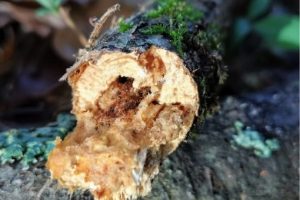City and forest ants are surprisingly similar genetically
City life could lead to differential evolution between urban and forest populations. Aurelie Khimoun and her collaborators showed, in their article published in Biology Letters, that urban populations of the tiny acorn ant are surprisingly not genetically differentiated from forest populations, suggesting expansion and lack of isolation. However, some genes display traces of selection that point towards an adaptation to the urban environment.

Une colonie de la fourmi Temnothorax nylanderi dans une branchette en forêt. © Mathieu Molet
Urban life can impact the evolution of populations. These populations, if they are isolated from non-urban populations, can become genetically differentiated through neutral (genetic drift) or adaptive (natural selection) processes. Aurélie Khimoun, from Université Bourgogne Franche-Comté, and her collaborators at Ecole Pratique des Hautes Etudes in Paris, Sorbonne Université in Paris, Université de Lyon and Texas Agricultural and Mechanical University, studied this process in the tiny accorn ant Temnothorax nylanderi, in their article published in Biology Letters. Their population genetics work revealed that, surprisingly, urbanization has no impact on genetic diversity within populations and genetic structure among populations. The demographic history of all populations is highly similar and it suggests an expansion followed by a recent decline. Despite the strong similarity among populations, the study detected 19 genes that are differentiated between forests and cities. These are associated with core cellular components, molecular function or biological process. Two of them are even linked with social traits. It thus seems likely that adaptation to urbanization and environmental changes can involve the evolution of new properties of group living. Studying the expression of these genes will help understand their exact social function.
Keywords
ants, urbanization, adaptation
Link to the article
https://royalsocietypublishing.org/doi/10.1098/rsbl.2019.0741
- extrait:
- lien_externe:
- kc_data:
- a:8:{i:0;s:0:"";s:4:"mode";s:0:"";s:3:"css";s:0:"";s:9:"max_width";s:0:"";s:7:"classes";s:0:"";s:9:"thumbnail";s:0:"";s:9:"collapsed";s:0:"";s:9:"optimized";s:0:"";}
- kc_raw_content:
City life could lead to differential evolution between urban and forest populations. Aurelie Khimoun and her collaborators showed, in their article published in Biology Letters, that urban populations of the tiny acorn ant are surprisingly not genetically differentiated from forest populations, suggesting expansion and lack of isolation. However, some genes display traces of selection that point towards an adaptation to the urban environment.
[caption id="attachment_7368" align="alignright" width="229"] Une colonie de la fourmi Temnothorax nylanderi dans une branchette en forêt. © Mathieu Molet[/caption]
Une colonie de la fourmi Temnothorax nylanderi dans une branchette en forêt. © Mathieu Molet[/caption]
Urban life can impact the evolution of populations. These populations, if they are isolated from non-urban populations, can become genetically differentiated through neutral (genetic drift) or adaptive (natural selection) processes. Aurélie Khimoun, from Université Bourgogne Franche-Comté, and her collaborators at Ecole Pratique des Hautes Etudes in Paris, Sorbonne Université in Paris, Université de Lyon and Texas Agricultural and Mechanical University, studied this process in the tiny accorn ant Temnothorax nylanderi, in their article published in Biology Letters. Their population genetics work revealed that, surprisingly, urbanization has no impact on genetic diversity within populations and genetic structure among populations. The demographic history of all populations is highly similar and it suggests an expansion followed by a recent decline. Despite the strong similarity among populations, the study detected 19 genes that are differentiated between forests and cities. These are associated with core cellular components, molecular function or biological process. Two of them are even linked with social traits. It thus seems likely that adaptation to urbanization and environmental changes can involve the evolution of new properties of group living. Studying the expression of these genes will help understand their exact social function.
Keywords
ants, urbanization, adaptation
Link to the article
https://royalsocietypublishing.org/doi/10.1098/rsbl.2019.0741
